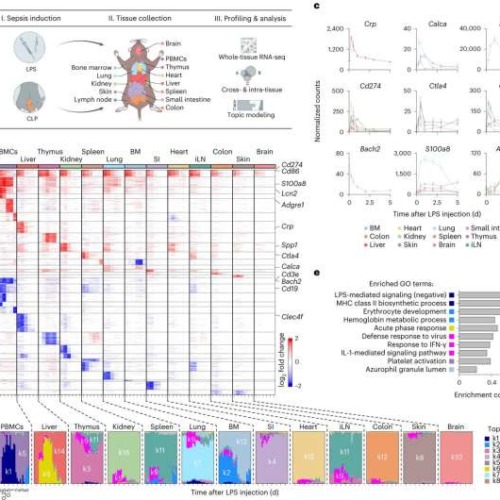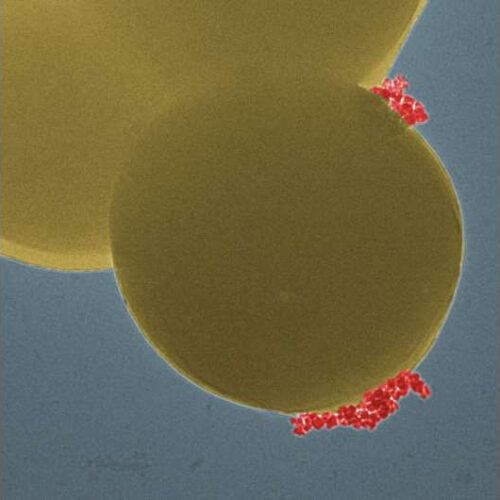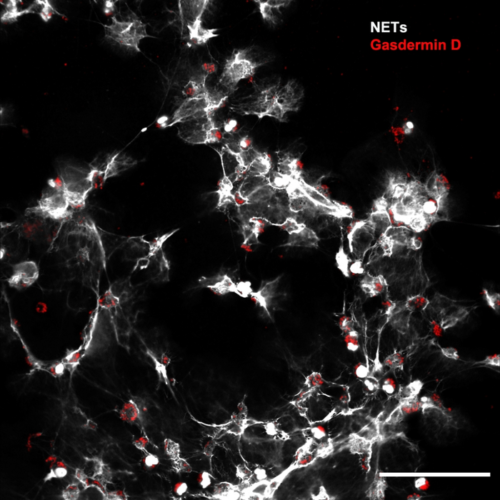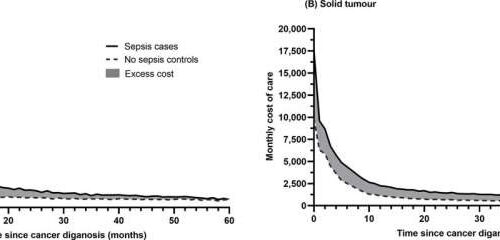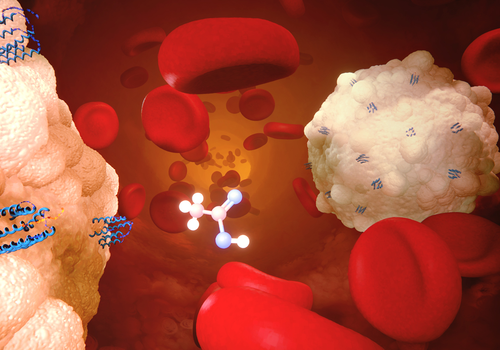by Emily Ayshford, University of Chicago Whole-tissue gene expression reveals the molecular effects of sepsis and endotoxemia across organs. a, Schematic overview of the experimental workflow. b, Heat map of DEGs (rows) from whole-tissue mRNA profiles ordered by k-means clustering (horizontal lines), organ types (top; colors) and time periods (bottom; tick marks for 0.25, 0.5, 1,...
Tag: <span>Sepsis</span>
Using magnetic nanoparticles as a rapid test for sepsis
by Swiss Federal Laboratories for Materials Science and Technology Magnetic nanoparticles (red) bind specifically to the spherical bacteria (yellow) which are about 1 µm in size (electron microscopy digitally colored). Credit: Empa Qun Ren, an Empa researcher, and her team are currently developing a diagnostic procedure that can rapidly detect life-threatening blood poisoning caused by staphylococcus...
Study presents novel therapeutic target for treatment of sepsis
FUNDAÇÃO DE AMPARO À PESQUISA DO ESTADO DE SÃO PAULO IMAGE: THE STUDY ALSO PROVED THAT A DRUG ORIGINALLY INDICATED TO TREAT ALCOHOL DEPENDENCE CAN INHIBIT THE MOLECULE’S ACTION AND PREVENT COMPLICATIONS CREDIT: CRID-USP A new strategy for preventing complications associated with sepsis is presented by researchers affiliated with the University of São Paulo (USP)...
Sepsis can result in a doubling of cancer care costs
by Peter MacCallum Cancer Centre Fig 1. Mean monthly cost of care by malignancy type. (A) Haematolgy. (B) Solid tumor. The shaded area represents excess cost associated with sepsis, solid line represents mean monthly cost of care among sepsis (cases), and dotted line for no sepsis (controls). Credit: DOI: 10.1371/journal.pone.0255107 New health economics research led...
Tübingen research team develops new strategy against sepsis
GERMAN CENTER FOR INFECTION RESEARCH IMAGE: THE ACETATE MOLECULE (CENTER) PUTS WHITE BLOOD CELLS (NEUTROPHIL GRANULOCYTES) ON ALERT VIA THE RECEPTOR GPR43 (BLUE). CREDIT: UNIVERSITÄT TÜBINGEN, MICHAEL PELZER As a result of local infection, bacteria can enter the bloodstream, which can lead to life-threatening sepsis (colloquially known as blood poisoning) and septic shock with organ...
Abdominal fat cells could aid sepsis fight
by University of Edinburgh Experts say the cells—located in the curtain of tissue that covers the intestines—play a vital role in containing the spread of peritonitis, which is triggered by abdominal infection after a perforation in the intestines. The study could pave the way for new treatments to combat sepsis, which kills more than 50,000...
Muscle weakness after sepsis linked to mitochondrial dysfunction
New findings may explain why humans experience muscle weakness after sepsis recovery, and suggest the need for novel treatments to improve muscle health ELIFE Damage to energy-producing mitochondria may underlie prolonged muscle weakness following a sepsis-like condition in mice, according to a new study published today in eLife. The findings may explain why humans struggle...
New bacterial strain linked to scarlet fever, sore throat and sepsis
by Imperial College London A team of scientists led by Imperial College London have discovered a new strain of group A streptococcus bacteria. Group A streptococcus (or Strep A) is known to cause scarlet fever, throat infections and—in very rare cases—invasive disease, where the bacterium enters the bloodstream or tissue and can trigger sepsis and toxic shock. The research team,...
15 Percent Of Sepsis Survivors Die Within A Year Of Leaving The Hospital: Study
By Naia Carlos Tech Times Sepsis patients aren’t out of the woods even getting through their life-threatening illness as research shows that the following years remain risky for survivors. If their illness was critical, sepsis survivors face a higher risk of dying even at least six years after recovering from their disease in the hospital. Long-Term Study Of Sepsis Survivors In the new research published in the...
Promising new drug shows potential to stop progression of sepsis
IMAGE: PROFESSOR STEVE KERRIGAN, RCSI. view more CREDIT: RCSI Thursday, 7 March 2019: Research into a new breakthrough therapy in the fight against sepsis has shown that the drug has potential to stop all sepsis-causing bacteria from triggering organ damage in the early stages of the condition. The pre-clinical trial of InnovoSep, carried out by researchers at RCSI (Royal College of Surgeons...
- 1
- 2

